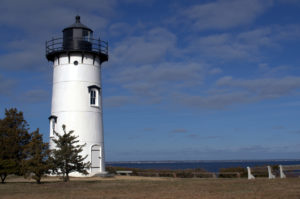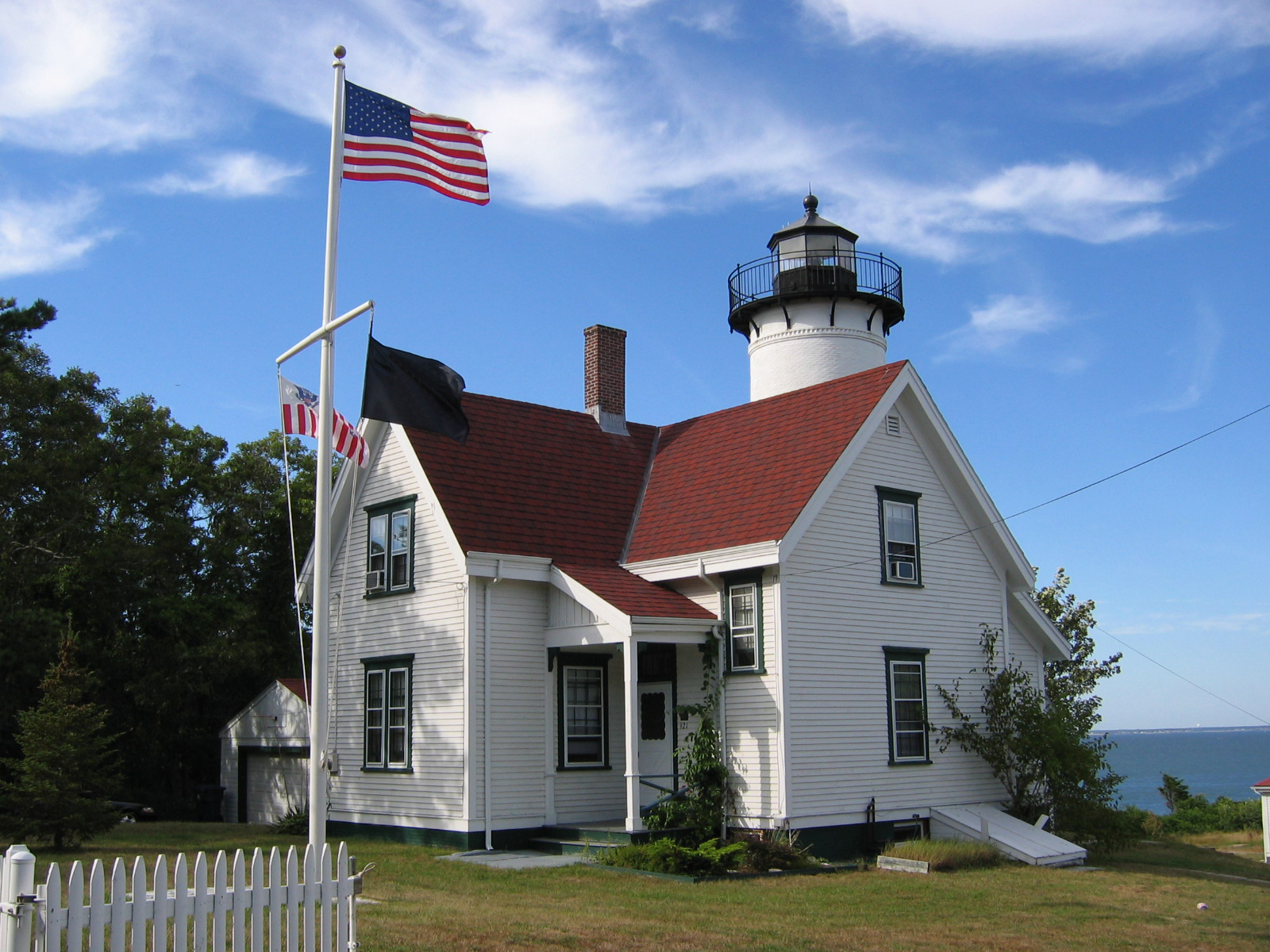
History of the East Chop Light
Chop is one of those words that can have an extraordinarily different meaning for those living in ocean towns than those who do not. When one sees the East Chop Lighthouse, the meaning is perhaps clearer. A chop, as referenced in this light sitting atop Telegraph Hill, refers to the entrance of a body of water. In the case of this Martha’s Vineyard landmark, it is one of a pair of lights illuminating the entrance of one of Martha’s Vineyard’s harbors.
While East Chop’s pair, West Chop, was established in 1817, East Chop remained without a light for the first half of the 19th century. In 1828, a semaphore station was built, giving Telegraph Hill its name, but residents knew that a light was necessary at the spot.
Governments would usually approve and install these important navigation aids but in 1869, a local resident, Captain Silas Daggett took matters into his own hands. Captain Daggett took it upon himself to build his own lighthouse, then advertised it in several newspapers with the following advertisement:
The undersigned has at a considerable expense erected a Lighthouse (to be known as the “Coaster’s Light”) on the East Chop of Holmes’ Hole Harbor. The height of the lantern above the level of the sea is about sixty feet, from which a fixed red light will be exhibited on and after June 5. Captains, owners and underwriters of vessels cannot fail to appreciate the convenience of the Light, and should therefore be willing to contribute to its support. Silas Daggett, Branch Pilot, Holmes’ Hole, Mass.
Captain Daggett was correct in thinking that local seamen and business owners would see the value of the East Chop Light. The light was maintained with donations from local business owners and of ships that docked at Vineyard Haven.
In 1871, the East Chop Light was heavily damaged in a fire forcing Captain Daggett to rebuild. This time, Captain Daggett got assistance from The Lighthouse Board. The Organization loaned him three twenty-one inch reflectors allowing him to maintain the fixed red light. With the new structure, the light was 76 feet above sea level.
The East Chop Light continued on as an independent enterprise for several more years, despite The Lighthouse Board publicly recognizing its need in 1873. In 1875, Congress finally appropriated the funds to build a proper East Chop Light and purchased the property from Captain Daggett the next year.
In 1877, construction began on a replacement light for East Chop. Captain Daggett’s original remains to this day as a part of a private home about fifty feet away. The new lighthouse would be a forty-foot-tall, cast-iron, conical structure with a nearby one and half story house for the lighthouse keeper.
Once construction was completed, a fourth-order Fresnel lens was installed at 79 feet above sea level. Initially the Fresnel lens was set to shine a solid white but in 1898 it was changed to flashing red. The light was changed once again in 1934 to a flashing green.
The Fresnel lens was an important innovation in lighthouse technology. Fresnel lens’ are constructed from a series of prisms, allowing for greater brightness with less glass and fuel usage. They come in a variety of orders which determine the size and focal length of the light.
To create the lights, a variety of fuels were used over the years. By the end of the 19th century, lighthouses were moving from the dirtier and more expensive sperm whale oils and lard oils to the cleaner burning, cheaper but more volatile kerosene. In 1898 a dedicated oil house was built near the East Chop Light to house the dangerous but effective fuel.
When this most recent cast-iron East Chop Light was built, it was originally painted white. Not long after it was built, sometime in the 1880s, the more typical white was replaced with a reddish brown. Locals were very fond of their unusually colored light, referring to it as the “Chocolate Lighthouse.” Unfortunately the darker color caused numerous heat and restoration issues so it had to be repainted white in 1988.
While the history of the various lighthouses on Martha’s Vineyard are in and of themselves fascinating, even more engaging are the stories of the people who manned them. The East Chop Light is blessed with one of the more colorful characters from lighthouse history, George Walter Purdy.
Purdy started as a lobsterman in Newfoundland eventually moving to Massachusetts and becoming a lighthouse tender on the ship Azalea. While on the Azalea, Purdy got his sleeve caught in some of the machinery, heavily damaging his arm. By the time the ship returned to port, gangrene had set in, forcing the arm to be amputated.
While losing his arm forced Purdy out of his work on ships, he was able to continue his marine career in lighthouses. He moved around quite a bit before settling in at East Chop in 1912, remaining there until 1934. He raised several children there. His daughter, Alice Purdy Ray, remembered their time at East Chop fondly many years later.
The house there, they don’t build them like that anymore…The roof was slate. In the wintertime it was beautiful. You would never know what the weather was outside if you were in the house. You wouldn’t know whether it was raining, blowing, sleet. The house was so solid it wouldn’t show anything. It was just as nice and warm as could be. In the summertime it was cool.
There was another building they called a tool shed, and there was a barn across the street. You see, Dad decided he had to have a cow so he asked the town if he could put a cow across the street. There wasn’t anybody there. It was just open field. They said, “Go ahead,” so he went out and bought himself a cow.
And we used to have a vegetable garden. You should have seen the garden my family used to have in there. Oh, those rambling roses. They’re still growing wild along the fence in front.
Purdy was also known for doing the work expected of several people, despite having only one arm to work with. He was remembered for moving several heavy boulders to allow the construction of a boat landing on his own. This was done in a manner such that the original purpose of the boulders, preventing erosion, was not hampered.
In 1934, the lighthouse was automated. The Purdy family was given the opportunity to rent the house they had lived in the past 22 years but chose to move closer to town. The house was then demolished which revealed that the wooden walls actually enclosing brick, explaining the surprisingly quiet structure.
While the East Chop Light, with its upgraded beacon installed in 1984, is still an active aid in navigation. It has mostly been replaced by more modern navigation techniques. It’s care was passed in 1985 to the Vineyard Environmental Research Institute (VERI) then to its current owner, the Martha’s Vineyard Museum in 1994.
Visiting the Lighthouse:
The East Chop Light’s address is :
229 East Chop Avenue, Oak Bluffs, MA
And can be contacted through the Martha’s Vineyard Museum at:
508-627-4441
For visitors who wish to see the lighthouse in person, East Chop is open seasonally on Sunday evenings around sunset.
East Chop Light is also viewable from the water from Martha’s Vineyard Sunset Cruises.
Accomodations Near East Chop Light:
There are no accommodations at the lighthouse proper but there are plenty of hotels nearby in Oak Bluffs including the Martha’s Vineyard Surfside Hotel, Hotel Ginger and the Pequot Inn.
Oak Bluffs has a variety of restaurant options near the harbor including seafood restaurants like Fishbone’s Bar and Grill and Nancy’s Restaurant as well as other cuisine options such as the Homespun American food at Linda Jean’s Restaurant or Mexican at Sharky’s Cantina.
The town of Oak Bluffs itself is a fun place to visit. It has a delightful mix of the quaint Martha’s Vineyard architecture with high spirited fun. Of particular note is the Flying Horses carousel, an antique brass ring game carousel from Coney Island, NY.
Both the East Chop Light and the town of Oak Bluffs are both well worth a visit.
Other nearby lighthouses:
West Chop Lighthouse – 13 minute drive – 5.1 miles
